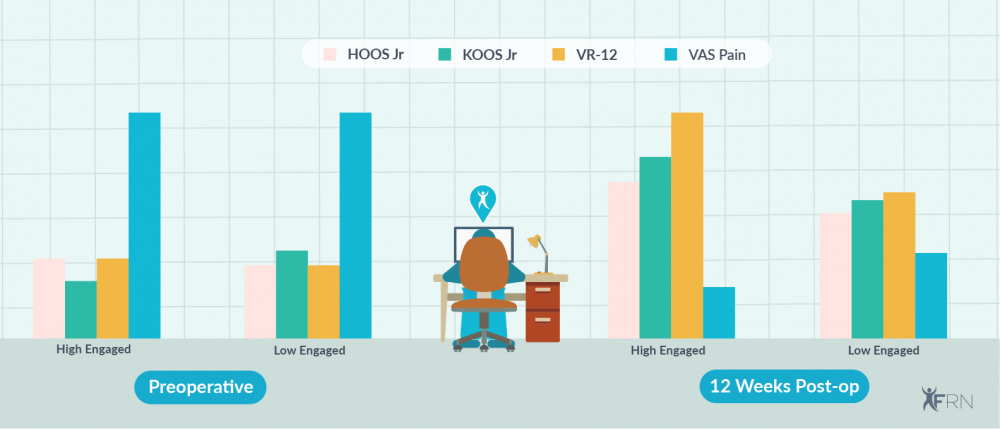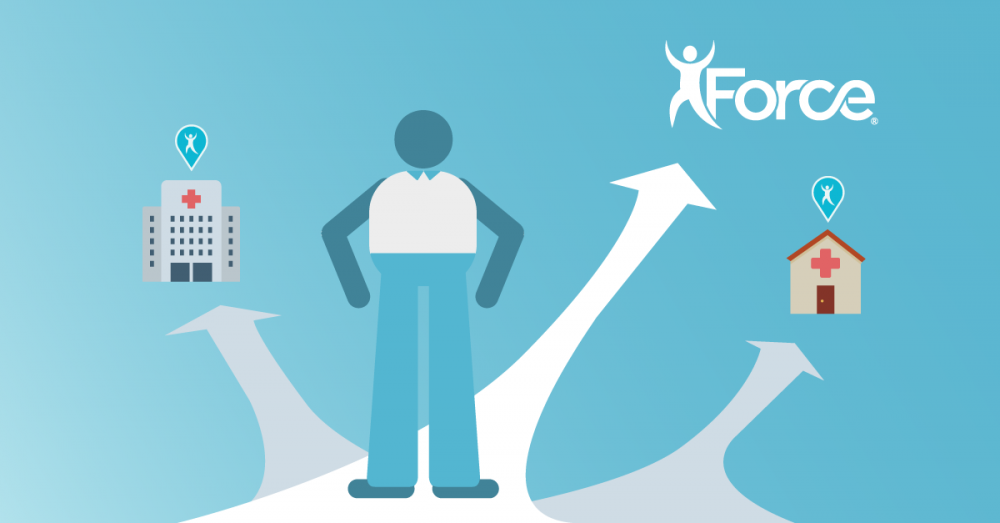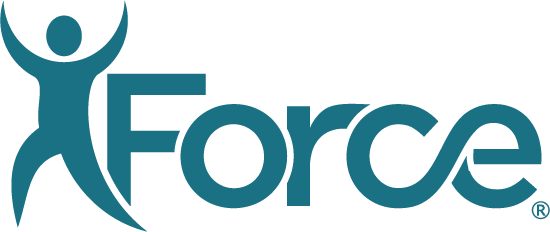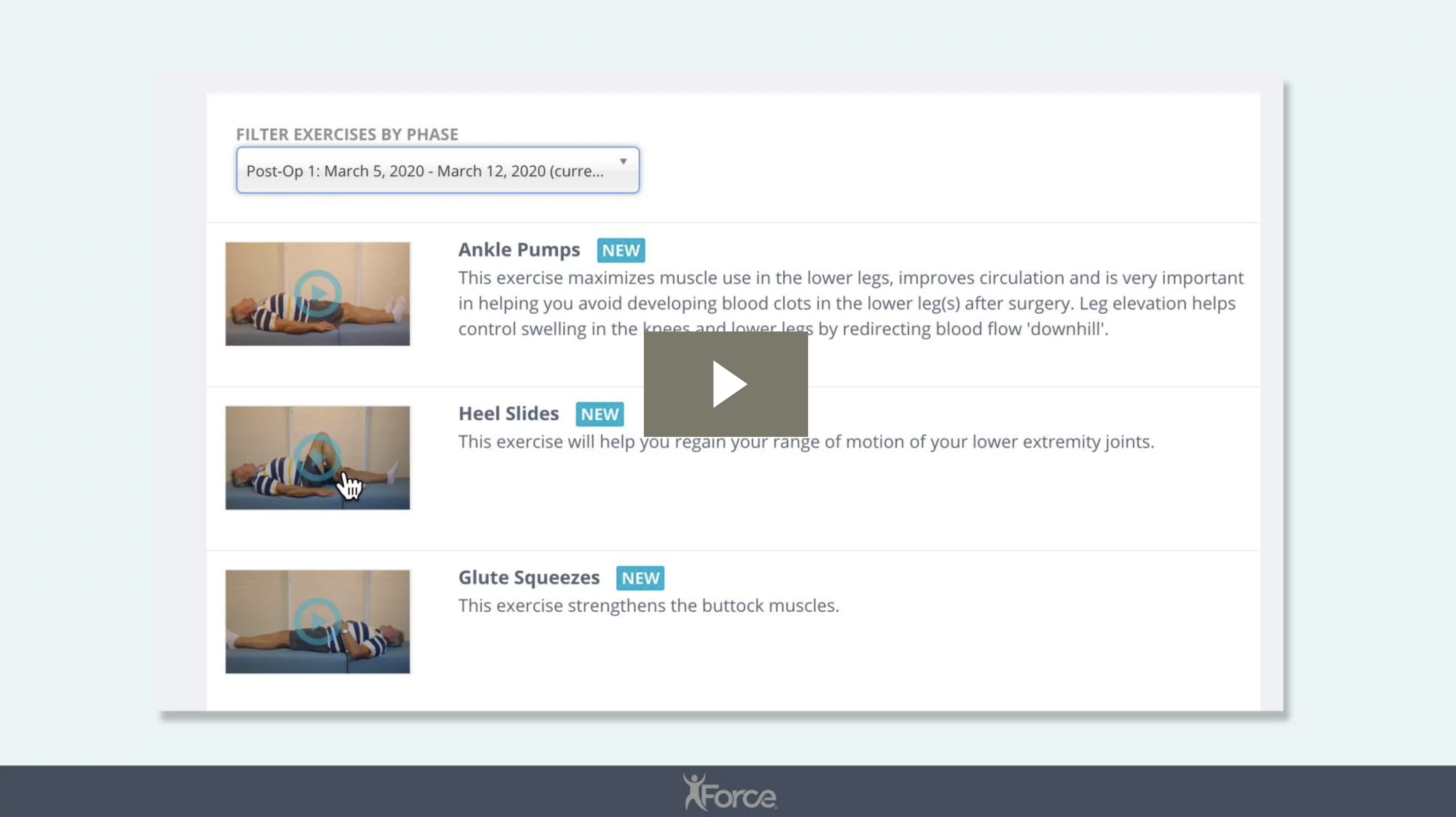According to a patient engagement study we conducted with NYU International Journal of Orthopaedics, Electronic Patient Rehabilitation Applications (EPRA) not only allows patients to become engaged in their recovery, but also was seen to save an institution over $400,000. Now, more than ever, we see digital health and AI driving meaningful business impacts to health systems that we work with. A successful patient engagement strategy is a huge contributor to innovators among the top hospitals, and one of the many benefits in investing in digital health tools. So, what exactly does this mean for your musculoskeletal medical programs?
The trend in same-day primary Total Joint Arthroplasty (TJA) at an ambulatory surgical center (ASC) rather than on site at a hospital is on the rise. This, partnered with the reduced time to achieve outstanding outcomes and improve patient experience at a reduced cost, is the driving factor as to why organizations are adopting technology for patient engagement. Prior research has demonstrated the link between preoperative patient engagement with postoperative outcomes.
The pressure on providers to change and adapt their operations to the new standards of excellence in healthcare is the exact reason why we have created a comprehensive guide to explain how to strategically build a patient engagement strategy.
Here’s a quick overview of what to expect throughout the blog:
- How to Increase Patient Engagement with Strategy
- Research Studies Correlated to Patient Engagement
- Case Studies of Successful Patient Engagement
- A Real Example of Patient Education Video in a Digital Health Platform
- Frequently Asked Questions
Although we will go into further detail of each item listed, here is a list of tactics to include in evidence-based patient engagement strategies and best practices:
How to Increase Patient Engagement with Strategy:
- Patient Activation
- Patient Education
- Communication Platform
- Rural Patient Engagement
1. Patient Activation (PAM)
An important piece of the puzzle of an agile patient engagement strategy is patient activation, which is a modifiable patient trait that has been shown to correlate to improved outcomes after surgery. Patient activation is essentially an individual’s willingness to take their recovery into their own hands, in a sense. They must understand the gravity of their role in their care, but first, must be equipped with the proper knowledge, and resources to do so. Those individuals who exhibit more responsibility and participation throughout their episode of care have high patient activation.
Screening and measuring patient activation levels before an operation affords the benefit of improved post-operative function recovery, while lowering the total cost of care. Musculoskeletal programs that leverage virtual care technology to engage and interact with their patients from afar will ultimately see higher patient activation, satisfaction, and true value in the long run.
Exhibit 1
In this 2020 study by Dartmouth-Hitchcock Medical Center of 245 patients undergoing Total Hip Arthroplasty, researchers proposed the following question: What is the effect of Patient Activation (PAM-13) on total hip arthroplasty patient’s postoperative PROMs?
Not only did higher patient activation levels lead to significantly higher global function and HOOS Jr after the surgeries, but also points to improved patient reported outcomes. Because of this study, it can be concluded that patient activation may be a considered modifiable predictor of patient outcomes after THA.
Read the full study below:
Patient Activation Correlates with Higher Patient Reported Outcomes After Total Hip Arthroplasty
2. Patient Education

Pre- and post-operative patient education should be utilized from start to finish of an episode of care to ensure the best possible outcome. To support this effort, our clinical solutions team at Force first works with the care team of the organization to optimize each individual’s healthcare journey and milestones to be sure patients receive the right information and education at the right time.
We leverage all historical data points collected from similar procedures to build a strong foundational plan, and customize it based on the organization’s patient engagement goals and unique needs. General patient education, step-by-step instructions, and guidelines relevant to their care journey can be found within the platform according to where they are in their recovery.
Exhibit 2
Discover what patient education in the Force platform looks like in this video:
Provided by Force Therapeutics
3. Communication Platform

A typical mean of communication between a healthcare provider and patient used to be a standard patient portal (SPP). That is quickly becoming a thing of the past, as pressure to improve quality care and at lower costs has become so much more prevalent. In a large hospital system spread across multiple facilities, postoperative evaluation involves travel, expense, and extensive planning for patients. The problem at hand with a standard patient portal is that it requires extraordinary efforts by physicians, physical therapists, and other caregivers to ensure appropriate clinical progress throughout the episode of care.
Alternatively, an electronic patient communication platform (EPCP), which offers a user-friendly interface as well as e-alerts via email and SMS, is more effective in monitoring patient progress. It is also important that an EPCP integrates into the system’s electronic health record (EHR) for seamless data collection and storage.
4. Rural Patient Engagement
Rural populations need to be a major consideration when building a patient engagement strategy. Although they will travel substantial distances for a specialized procedure, we all know it is unrealistic for patients to continuously travel from far away for a doctor’s visit, post-op. This is where leakage becomes a huge issue, making it nearly impossible to track that individual’s recovery progress if they are seeing separate providers, or simply not seeing anyone.
How is your organization going to provide the same level of care that local patients can receive at in-person appointments? The simplest solution to this is by leveraging remote digital care that is adaptable to your health care system’s needs. Staying connected with members and delivering high-quality care in a safe and accessible manner is more important than ever. Despite concerns that patients in rural areas may be slower to embrace new healthcare technology, we have actually found that it is the complete opposite of that. Patients in all geographic locations preferentially use an intuitive communication platform over the previously-used SPP.
Exhibit 3

The rural patient population presents a unique challenge for health systems to deliver the necessary continuity of care. According to National Rural Health Association, there are 30 specialists per 100,000 residents in rural areas versus 263 specialists per 100,000 residents in urban areas.
As a result, patients in rural communities are located farther away from their medical providers compared to those who live in more urban settings, resulting in longer travel and time off work. Expanding healthcare access to rural areas seems like a simple solution, but it is not a cost- and time-efficient solution as it requires a considerable up-front costs and long-term planning.
Over the years, many hospitals and health systems have begun to identify digital health as a potential solution. The objective of the following study conducted by Force Therapeutics showed that remote and rural patients tend to be more inclined to use an online platform for their post-surgical care. Online platforms could be a viable solution to the lack-of-access issue posed by rural populations.
Impact of Geographic Location on Online Patient Engagement in Rural Orthopedic Population
Frequently Asked Questions
How can patient engagement improve quality of care?
- Higher levels of patient engagement has proved to directly relate to lower pain levels, shorter recovery periods and less return to hospitals. Not only can patient engagement lead to a more satisfying recovery for the patient, but it can also be more cost and time efficient for providers.
- In fact, in this study, we discover that patients who were more engaged with online patient engagement technology had significantly better postoperative outcomes. Ultimately, patients who are more active on the Force Therapeutics platform are more likely to succeed postoperatively over patients who are less engaged.
What are a few examples of patient engagement activities?
- A few examples of patient engagement methods could be watching instructional videos, logging physical therapy hours, reporting pain levels and medication intake, as well as tracking exercise and movement. This can all be done by using a scalable, adaptable patient engagement tool, like Force’s platform.
What is considered high or low patient engagement on a digital platform?
- Patient engagement can be measured as the degree to which patient are taking active roles in their care or recovery. Patients who participate in such activities on the digital platform allow providers and care teams much more specific illustration on how their recovery is going. The more patients participate in activities and “assignments”, the higher their engagement rate will be.
- On the other hand, if a patient has low engagement rates, providers have a very difficult time tracking the patient’s recovery journey. Force has a dedicated team on hand to steer the individual through the patient navigation tool, to ensure they are empowered with the necessary information to be actively engaged in their recovery.
How can patient engagement affect an episode of care?
- The technology used in the patient engagement platforms, such as Force’s platform, allows patients to play an active role in their recovery through engaging with pre and postoperative exercise videos, care instructions, messaging, reminders, and more.
- Harvard Business Review states, “As payment and care delivery models shift in the United States from episodic, fee-for-service care toward population health and value-based reimbursement, health care leaders are focused more than ever on patient engagement as a key to driving down costs and improving outcomes […]” “Rather than having patients as passive recipients of care, they must be active producers of their care, in partnership and coordination with physicians and clinical staff.”
How can I leverage patient engagement to verify a digital platform?
- Patient engagement relates to the quality of remote patient monitoring by heath teams and providers. The data collected from an engaged patient on a telehealth platform and be used to inform future care plans prescribed by clinicians. For example, in this study, the data suggests that highly engaged patients undergoing lumbar procedures report less pain postoperatively, which can be used to verify the need and value of a care platform.
The benefits to leveling up your service lines with an innovative patient engagement tool are endless. We continue to study outcomes and help our clients pinpoint areas within their programs that can be improved to better the patient’s overall care experience and streamline processes for long-term cost savings. At the end of the day, patient activation, education, and communication should all be key players in your patient engagement strategy. If they aren’t, you are missing out on opportunities to maximize each patient’s experience and recovery outcomes.
If that’s not enough, organizations saved thousands of dollars each year by investing in engagement tools, but in turn, also see significant improvements in market share growth without experiencing growing pains by having to make quick hires, because a scalable platform saves the care team time. We are proud to see that 16% of the hospital systems on the 2020-2021 Top 50 US News Rankings are partnered with Force and utilize our platform as their primary patient engagement tool.




